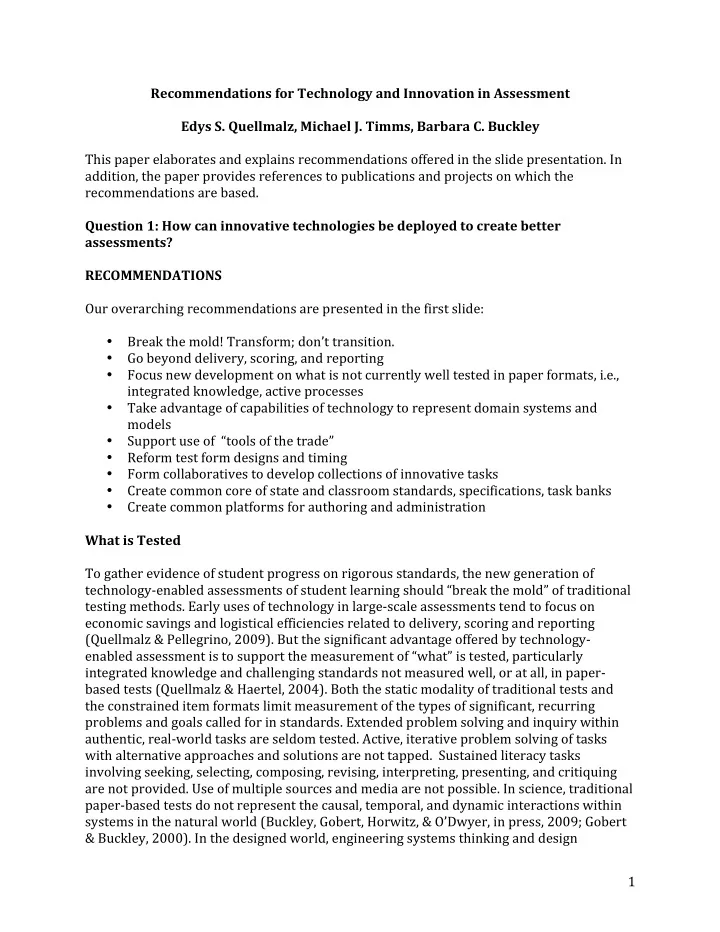

Recommendations for Technology and Innovation in Assessment Edys S. Quellmalz, Michael J. Timms, Barbara C. Buckley This paper elaborates and explains recommendations offered in the slide presentation. In addition, the paper provides references to publications and projects on which the recommendations are based. Question 1: How can innovative technologies be deployed to create better assessments? RECOMMENDATIONS Our overarching recommendations are presented in the first slide: • Break the mold! Transform; don’t transition. • Go beyond delivery, scoring, and reporting • Focus new development on what is not currently well tested in paper formats, i.e., integrated knowledge, active processes • Take advantage of capabilities of technology to represent domain systems and models • Support use of “tools of the trade” • Reform test form designs and timing • Form collaboratives to develop collections of innovative tasks • Create common core of state and classroom standards, specifications, task banks • Create common platforms for authoring and administration What is Tested To gather evidence of student progress on rigorous standards, the new generation of technology‐enabled assessments of student learning should “break the mold” of traditional testing methods. Early uses of technology in large‐scale assessments tend to focus on economic savings and logistical efficiencies related to delivery, scoring and reporting (Quellmalz & Pellegrino, 2009). But the significant advantage offered by technology‐ enabled assessment is to support the measurement of “what” is tested, particularly integrated knowledge and challenging standards not measured well, or at all, in paper‐ based tests (Quellmalz & Haertel, 2004). Both the static modality of traditional tests and the constrained item formats limit measurement of the types of significant, recurring problems and goals called for in standards. Extended problem solving and inquiry within authentic, real‐world tasks are seldom tested. Active, iterative problem solving of tasks with alternative approaches and solutions are not tapped. Sustained literacy tasks involving seeking, selecting, composing, revising, interpreting, presenting, and critiquing are not provided. Use of multiple sources and media are not possible. In science, traditional paper‐based tests do not represent the causal, temporal, and dynamic interactions within systems in the natural world (Buckley, Gobert, Horwitz, & O’Dwyer, in press, 2009; Gobert & Buckley, 2000). In the designed world, engineering systems thinking and design 1
problems involving proposals for alternative designs, testing them, and evaluating tradeoffs are not typically well tested. Collaboration, a crucial 21 st century skill, is not tested with real or virtual peers and experts. The new generation of technology‐enabled assessments can move past items testing decontextualized, discrete knowledge of simple facts and concepts. Innovative tasks can give greater emphasis to assessing understanding of the models and organizational structures and types of strategic reasoning within subject domains and their application to situations. In science, technology can organize innovative tasks to address grade appropriate models of systems in life, physical, and earth science. English language arts literacy tasks may be clustered within broad categories of narrative, persuasive, and informative discourse aims and generic discourse structures employed to achieve communication purposes. In mathematics, prototypical problem types can embed component skills. Importantly, technology‐enabled assessments allow design of innovative tasks in which students use technologies that are “tools of the trade” in the domain and that are routinely employed in postsecondary education and the work place. These tools support new levels of thinking and reasoning by broadening methods for finding and collecting information and data and for using tools to manipulate information and data during problem solving and interpretation. Information and communications technologies such as web browsers, word processors, editing, drawing, and multimedia programs support research, design, composition, and communication processes. These same tools can expand the cognitive skills that can be assessed, including planning, drafting, composing, and revision. In science, technology, engineering and mathematics (STEM), tools of the trade would include simulations, models, and visualizations, and tools for data collection, representation, and analysis. Innovative assessment tasks could elicit evidence of students’ problem solving, inquiry, and decision making processes, and multiple appropriate solutions, as well as proficiencies with the tools. Slides 3‐8 describe the increasing use of innovative, technology‐based tasks in major large‐ scale national and international assessments and their potential in a new generation of formative and summative tests. Online testing now occurs in numerous international, national, and state assessment programs. The 2009 Programme for International Student Assessment (PISA) included electronic texts to test reading, and in 2006 PISA conducted a pilot of computer‐based assessment in science. The National Assessment of Educational Progress (NAEP) studied online versions of mathematics and writing tests in preparation for transitioning NAEP to electronic administrations in the near future (Sandene et al., 2005). Currently, over 27 states have operational or pilot versions of online tests for their statewide or end‐of‐course exams. This includes Oregon, which pioneered online statewide assessment, North Carolina, Utah, Idaho, Kansas, Wyoming, and Maryland. The 2011 NAEP writing assessment will require use of word processing and editing tools to compose essays. In professional testing, architecture examinees use computer assisted design programs (CAD) as part of their licensure assessment. The 2012 NAEP Technological Literacy Framework lays out examples of assessment targets, task scenarios and illustrative tasks that will guide the development of innovative tasks to be computer 2
Recommend
More recommend